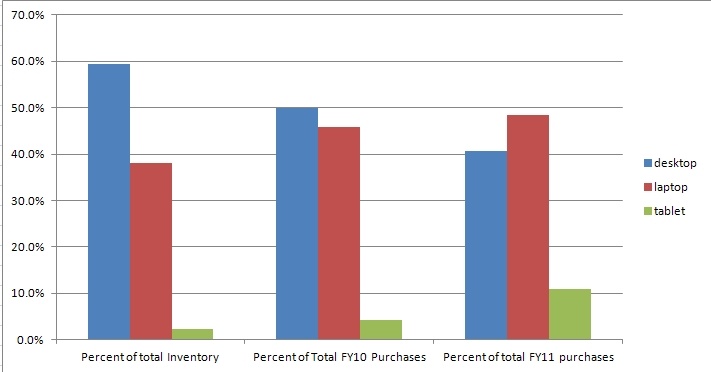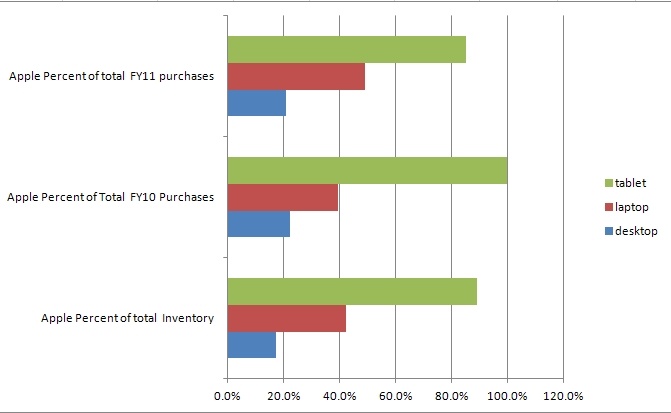With the Help of Property Management and Procurement, we were able to come up with statistics on recent computer workstation purchase trends (as compared to the total inventory as recorded in the Property System). We also added in recent estimates of lab issued smartphones
Workstation Trends
Device |
Total Inventory Dec 2011 |
Apple inventory |
Total FY10 purchase |
Apple FY10 purchase |
Total FY11 purchase |
Apple FY11 purchase |
Desktops |
7471 |
1284 |
901 |
199 |
806 |
168 |
Laptops |
4796 |
2030 |
828 |
327 |
960 |
470 |
Tablets |
299 |
266 |
77 |
77 |
215 |
183 |
Smartphones |
630 |
600 |
|
|
|
|
Trends: more mobile devices, more Apple. Also multiple devices per person
Note: The lab has several thousand affiliates and computer's associated with scientific instruments so the computers/career employee can not be generalized beyond our type of business
Visualized graphically, the data looks like this:
Apple "market share" - in mobile devices (laptop, tablets). For a number of years, Mac Laptops have been widely used - so the most recent two years do not show a dramatic change. In FY10, the only tablets were iPads, but we are starting to see a few others now (e.g. Samsung Galaxy).
What was installed:
Cluster support group added the following:
- 1 new storage node added
Business Systems group added the following:
- No new systems
What was removed:
Cluster support group removed the following:
- No Systems
Business Systems group removed the following:
- No systems
November average Power Usage Effectiveness (PUE): unknown
- Average Power Consumption:
- 350kW IT
- 1kw Lighting
- 24.1kw Building and IT Losses
- xxxkw Cooling Power
- Average Cooling Load: 99 tons
No pie chart this month due to software error
Data Center Efficiency Progress:
The DOE national average PUE for data centers is 1.75. 50B-1275 data center has evolved from an average PUE of 1.65 (calculated in 2009) to today’s 1.47. Getting there, staying there, and further improving the PUE is an ongoing effort.
Key highlights for this month include:
- Average room temperature was raised this month. With many cabinets on the business systems side of the room now empty due to virtualization, cold air was coming up through openings now void of cables. The additional cold air was keeping the average room temperature in the 68 degree range. By plugging the opening, the room temperature in isle ways and unused areas rose to 72 to 74 degrees. Cold air at top of racks in active areas remained within server inlet temperature ranges.
- CPU energy use has continued to decrease during the month due to drop in CPU utilization, dropping the total IT energy use to about 2007 levels.
- The new VFD software to automatically control the Air Handler air flow was installed mid month. To enable testing we turned on all the air handlers. For these reasons the PUE has gone up considerably, which is expected during testing. By month end we were seeing large swings in CRAC energy use, indicating a possible problem with the software.
- One temperature sensor used to calculate chiller energy use failed at the start of the month. The sensor provided erroneous data used for calculating the PUE.
Strategic Direction (as of December 2011).
At the present time, the IT Division manages three different mail list services: smartlists, majordomo, and sympa (open source mail list software). We are consolidating these three into an updated version of sympa (which was put into production in the fall of 2011). We are retiring majordomo lists and gradually moving ones that need to continue to sympa. At the same time, we are planning to use sympa for dynamic "smart lists" which reflect current information that is reconstructed each day and typically are used for level one lists where membership changes frequently.
lists.lbl.gov is the home of our self service Sympa based system. Lists using Sympa can be created by anyone at the lab - but can also be handled by the IT Help Desk. Any mail list created using this service will have the address of "listname"@ lists.lbl.gov. If a mail address that conforms with our more traditional "name"@lbl.gov is required, ask that an alias to be created by entering a help request at help.lbl.gov.
For more information, check out the mail list FAQ.

